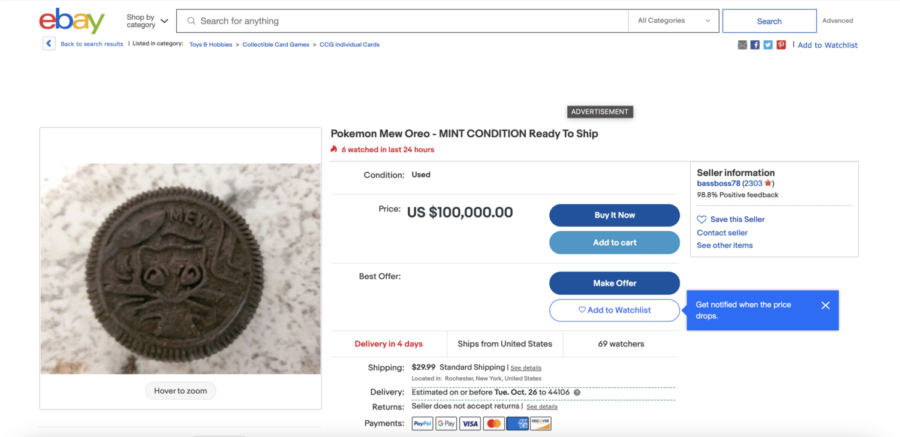Kuntzman: I unknowingly ate a $15,000 Oreo
Why is anyone spending this much on a cookie?
Caroline Kuntzman/The Observer
A Pokemon Mew Oreo is currently listed on eBay for $100,000 plus $29.99 shipping.
October 22, 2021
On Sept. 18, 2021, I made what I considered at the time to be the unremarkable decision to eat a Mew Oreo. It tasted no different from the other Pokemon Oreos I ate that day, to the best of my recollection. At the time that I ate it, I thought of the Oreo as normal and unremarkable. The design was cute, and I knew from my childhood that Mew is a legendary Pokemon. Still, I didn’t think that the Mew Oreo I found was particularly rare, valuable or otherwise exceptional in any way.
I learned that this was not true when one of my roommates told me that a Mew Oreo sold online for $200. I was even more surprised when I later received a message in my family’s Google Hangouts chat informing me that somebody bought a Mew Oreo for $10,000. After searching online, I found out that Mew Oreos have been sold for as high as $15,000. One particularly ambitious seller listed a Mew Oreo for “$100,000 + $29.99 shipping or Best Offer”. Other sellers selected lower prices, with offers starting at $50, which is still a considerable markup as vendors such as Target sell an entire family pack of Pokemon x Oreo Oreos for $3.79. These lucrative sales are not few and far between. According to Insider, more than 6,000 Mew Oreos had been listed on eBay as of September 27.
As someone who has eaten a Mew Oreo, I can say that I would not pay $15,000, $10,000 or even $50 for the Oreo I ate, and not just because of financial limitations. At a surface level, the Mew Oreos should have no higher value as they taste the same and presumably have the same nutritional content as any other Oreo, therefore giving them identical utility. Its status as a legendary Pokemon may be driving up interest among Pokemon fans. Scarcity is a probable contributor to the perceived value of the Mew Oreos. Oreo shared on Instagram that it is producing different quantities of its various Pokemon Oreos. The company divided the types into four categories: easiest to find, easy, hard, and hardest to find. Mew Oreos were the only variety that Oreo listed as hardest to find and, therefore, the rarest; a marketing move that seems like a deliberate effort to increase the value of Mew Oreos, specifically. With that being said, these Oreos are being sold online for thousands of dollars, which raises the question of why buyers are willing to spend so much on a cookie.
The rising price of Pokemon cards in 2020 may help explain the Mew Oreo frenzy. 2020 saw record-breaking Pokemon card prices, with a single booster pack selling for $360,000. The exact cause for the inflated prices is somewhat unclear, but it appeared to be a combination of nostalgia, pandemic-related boredom and the popularization of Pokemon cards on YouTube that drove the prices up. Pokemon cards are not the first product to have experienced such a dramatic price increase, with other collectibles such as Beanie Babies also selling at high rates. In 2020, Beanie Babies such as Claude the Crab sold for as high as $10,000 on eBay, showing that this odd price gauging phenomenon is not unique to Pokemon merchandise.
With normalcy beginning to return in the United States, the conditions of the Mew Oreo sales are different from the inflated Pokemon card prices. What further differentiates the interest in Mew Oreos from Pokemon cards is the nature of the product. While classified as non-perishable, Oreos are a food item; if used as intended, they are a one-time use product, unlike Pokemon cards and Beanie Babies. The duration for which the products are usable is also very different. Oreos are considered fresh approximately one to two months after their listed best buy date if their packaging is unopened. With a listed best by date that is typically nine months after their production, Oreos have a total shelf life of 10 to 11 months, providing a generous but still finite window to eat them within. Even if kept as a collectible, it would still be challenging to prevent a Mew Oreo from rotting eventually due to the natural presence of decomposers such as bacteria and fungi in any given environment, making them a poor choice of keepsake.
The inflated price of Mew Oreos creates a strange situation for consumers. Would I have acted differently had I known how much the Mew Oreo I ate could have sold for? The fact that I was unaware of the Mew Oreo’s potential value when I found it is probably for the best. Gael Fashingbauer Cooper, the author of the pop culture blog “Pop Culture Junk Mail”, expressed a similar dilemma after receiving a Mew Oreo in a promo box from Oreo: should they snack, save or sell? Receiving a seemingly everyday item with exceptional value leaves consumers with unusual decisions to make.
Producer efforts to increase the value of Mew Oreos appear to be at play, although Nabisco, Oreo’s parent company, alone should not be held responsible for this phenomenon. Pokemon X Oreo products hit the market after Pokemon card sales spiked, suggesting that Nabisco wanted to capitalize off of the increased interest in Pokemon. The decision to make and advertise Mew Oreos as rarer than the other Pokemon Oreos certainly set the stage for expensive resales. However, consumers and resellers chose to set and accept such high prices for Mew Oreos.
What the future of Pokemon Oreo sales will look like is unclear, but if it follows the same path as Pokemon card sales, it may not look good for casual consumers. To manage the demand for Pokemon cards, vendors, such as Target, capped how many buyers can purchase at a time. Whether or not the same could happen with Pokemon Oreos is unclear, but retailers and consumers alike should not have to deal with rationing methods. Keeping everyday items at everyday prices is a collective responsibility, so buyers need to be responsible and reasonable in what they are willing to pay for desired items.



